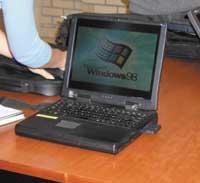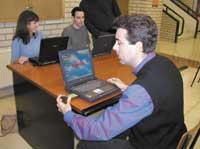Wireless Internet Connection
Students of the Faculty of Computer Science of San Sebastian no longer have to enter the library or laboratory and plug the laptop in order to surf the Internet. You only have to purchase a card at the faculty to connect. In this way, taking advantage of the good weather conditions, they can work in the same meadow of the faculty. All this thanks to the project launched by the faculty and the Computer Service of the faculty (CIDIR). It is a pilot project.
Wireless Area System

In the words of Pello Sánchez, project director, “it is very similar to the mobile phone system. Access points are installed at several points and, where there are no obstacles, serve for a radius of 150 meters. According to the barriers, this space is reduced”.
The information that goes from the computer to the access point is transmitted by radio frequency and each access point is wired to the data network, as if it were another computer. For the moment, the Faculty of Computer Science has three access points, the library and the Barriola building where the classrooms are located. Thus, at the entrance of the faculty, in the cafeteria, in the library, in the classroom open 24 hours and in several points outside the faculty you can access the system.
Each access point costs 68,000 pesetas and can transmit 11 Mb per second. These 11 megabites are distributed among connected users, so the more users connect to the access point, the slower it will work. It is recommended to connect to each access point ten users, but these limits can be exceeded by adding the access points.
To connect the laptop to the access point, as indicated, a card is inserted into the computer. Each card costs 28,000 pesetas. Pello Sánchez has specified that “by using it for the first time, we prepare the CD-Rom that is installed alone.” From there just enter the card.
The technology is called 802.11 b and 802.3 is a variation of the standard communication of local Ethernet networks. This variation allows to work wirelessly on a local network.
The 802.11 a technology is already developed but is not yet used, since the distribution of licenses has not been made. This system will work much faster: From a speed of 11 Mbps to 50 Mbps.
Multi-use system

The pilot project is currently aimed at students, but Pello Sánchez indicates that it can have other uses. “For example, in almost all buildings there is the possibility of connecting to the Internet by cable, but not at all. In addition, if there is no take near the place where you want to place the computer, the system can be comfortable.
On the other hand, cutting of the cable Internet connection over a period of time due to work will also help reduce discomfort. Finally, there will be one more service for external teachers who attend the lectures. From your computer you can, for example, introduce the card and use it without obstacles.”
According to Pello Sánchez, it is still early to tell us what his response will be, and we must wait for the service to be extended orally. In any case, it is aware that not all students have a laptop, so you should measure the need for this service. In case the need to expand the service is detected, it will extend to other buildings of the Faculty and the gardens of the Faculty will also be covered. At the moment there are six cards in the faculty and are usually occupied two or three.
It is a system that is triumphing at European level. In the last computation, 40,000 access points were recorded in Europe and 90,000 points are expected by 2005. It is spreading mainly in libraries, museums, classrooms of culture, airports, accommodations, etc.
Buletina
Bidali zure helbide elektronikoa eta jaso asteroko buletina zure sarrera-ontzian











